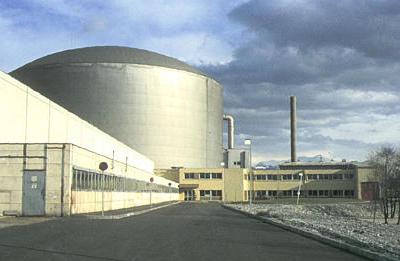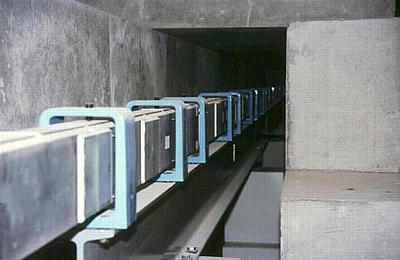 |
Guide Halls & Guide Tubes |
 |
Guide Halls & Guide Tubes |
Guide Halls
Given that there is limited space around a reactor core for scientific instruments, one solution is to provide additional space by the creation of guide halls. An external view of the two guide halls at the ILL is shown in the left-hand photograph below:
 |
 |
Guide halls have several advantages and disadvantages: Radiation safety is an obvious advantage since scientists can do their experiments in a separate external to the main reactor shell (building). Reduction of neutron intensity might seem to be a potential problem, but this is alleviated by the use of neutron guides tubes (discussed next). The right-hand photograph above shows the inside of the first guide hall at the ILL, in the late 1980's (as viewed from the reactor). The yellow/orange/red instrument in the foreground was the small-angle scattering diffractometer D17, while the blue instrument further back is the time-of-flight (TOF) spectrometer IN5. All the instruments on this side of the guide hall make use of cold-neutron guide tubes. The original two powder diffractometers at the ILL are out of sight being located on thermal neutron guides on the other side (far right) of the guide hall.
Guide Tubes
Without guide tubes it would be impossible to do experiments at long distances from the reactor core due to the loss of neutron flux. Neutron guides are made of nickel-coated glass assembled as a rectangular cross-section (say 5 cm wide × 20 cm high) as shown in the photograph below, again taken at the ILL, Grenoble. Neutrons travelling approximately parallel to the guide are kept within the tube by a process of internal reflection. The reflectivity of the guide is a function of the coherent scattering length, b, and can be improved by using isotopic 58Ni, which has a higher b value than the naturally abundant form. A recent development in the manufacture of neutron guides has been the use of multi-layers for the surface coating to improve the reflectivity.

Neutron guides have an additional function: by creating a guide tube with a small curvature it is possible to eliminate some of the gamma radiation from the reactor. The gamma radiation travels in straight lines and goes through the walls of the guides and into the heavy concrete shielding. The curvature of the guide also eliminates short wavelength neutrons since neutron reflectivity is strongly wavelength dependent. This makes guide tubes unsuitable for use with hot neutrons, satisfactory for thermal neutrons, and very good for cold neutrons.
| © Copyright 1997-2006. Birkbeck College, University of London. | Author(s): Jeremy Karl Cockcroft |